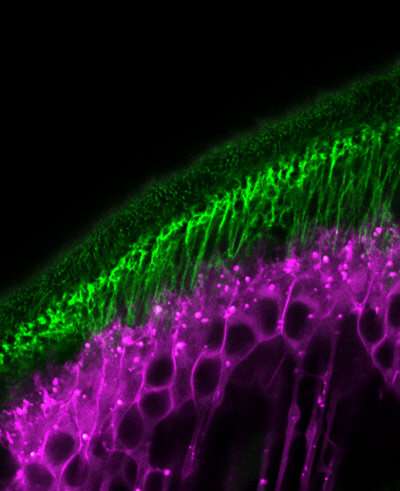Dumpy and Quasimodo proteins enable tendons and muscles of fruit flies to develop in sync

Two proteins play a key role in the development of flight muscles and their tendons in fruit flies, two RIKEN developmental biologists have shown1. Their study reveals how the components of the muscle–tendon system develop in sync with each other, thereby avoiding catastrophic results.
During the development of an animal, its cells construct non-cellular structures outside of themselves called the extracellular matrix—a complex mesh of proteins and polysaccharides that provides physical scaffolding for cells and also helps regulate cell growth and differentiation.
While biologists know a lot about the internal mechanisms of cells and how they are assembled into tissues, they know comparatively little about how cells secrete materials and assemble them into external structures such as the extracellular matrix, says Shigeo Hayashi of the RIKEN Center for Biosystems Dynamics Research (BDR). "The construction of extracellular structures is an engineering challenge, especially at the very small scale of molecular assembly," he explains. "This is why my group is studying the assembly mechanisms of the extracellular matrix."
Now, by looking at mutant fruit flies, Hayashi and Wei-Chen Chu (also of BDR) have uncovered the roles two proteins—Dumpy and Quasimodo—play in the development of the extracellular matrix that forms between the tendons attached to a fly's flight muscles and its exoskeleton during the pupal stage.
The flight muscle is the most powerful muscle in the insect body. It is critical that the tendon develop in step with the muscle because otherwise the muscle will pull the tendon away from the exoskeleton, resulting in a flightless fly.
Hayashi and Chu discovered that an extracellular matrix made of Dumpy filaments anchors the tendon cells to the hard exterior layer of the pupa. During development, tension generated by the flight muscles causes this extracellular matrix to remodel and form nanoscale filaments, increasing the strength of the matrix. "We found that stimulus from the muscle promotes tendon development and that, in this way, the tendon develops in tandem with the muscle."
But that mechanism alone is not enough to produce a sufficiently strong tendon and extracellular matrix—Quasimodo is also needed to enhance the strength of the extracellular matrix. Unlike Dumpy, Quasimodo is not a component of the extracellular matrix; rather it strengthens the matrix by some indirect mechanism that is currently not well understood. "This was the biggest surprise for us," says Hayashi. "Quasimodo is an unconventional extracellular matrix protein that diffuses through the whole body and modifies the activity of other extracellular matrix proteins."
More information: Wei-Chen Chu et al. Mechano-chemical enforcement of tendon apical ECM into nano-filaments during Drosophila flight muscle development, Current Biology (2021). DOI: 10.1016/j.cub.2021.01.010
Journal information: Current Biology
Provided by RIKEN




















